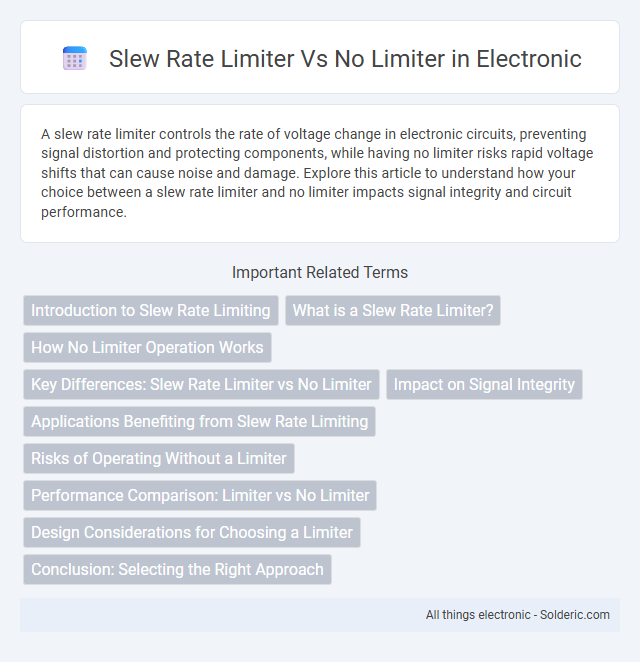A slew rate limiter controls the rate of voltage change in electronic circuits, preventing signal distortion and protecting components, while having no limiter risks rapid voltage shifts that can cause noise and damage. Explore this article to understand how your choice between a slew rate limiter and no limiter impacts signal integrity and circuit performance.
Comparison Table
| Feature | Slew Rate Limiter | No Limiter |
|---|---|---|
| Purpose | Controls rate of change of signal | No control on signal rate |
| Signal Smoothness | Reduces abrupt transitions | Allows abrupt changes |
| System Stability | Enhances stability in control systems | Potential for instability due to rapid changes |
| Use Case | Robotics, audio processing, power electronics | Simple systems without rapid signal concerns |
| Hardware Complexity | Higher due to added components | Lower, simpler design |
| Signal Delay | Introduces minimal delay to limit rate | No signal delay |
Introduction to Slew Rate Limiting
Slew rate limiting controls the maximum rate of change in an analog signal, preventing abrupt transitions that can cause distortion or hardware stress. Without a slew rate limiter, circuits may experience overshoot, oscillations, or signal integrity issues due to rapid voltage changes. Implementing a slew rate limiter ensures smoother signal transitions, enhancing performance and reliability in audio, control systems, and analog signal processing.
What is a Slew Rate Limiter?
A slew rate limiter controls the rate of change of a signal, preventing abrupt transitions that can cause distortion or instability in electronic circuits. Unlike having no limiter, which allows instantaneous voltage or current changes, a slew rate limiter ensures smoother and more predictable signal modulation. This controlled signal variation is critical in audio processing, analog-to-digital conversion, and power supply regulation to maintain signal integrity and reduce electromagnetic interference.
How No Limiter Operation Works
No limiter operation allows the signal to change instantaneously without any restriction on the rate of change, resulting in a direct and unprocessed output response. This approach can cause undesirable high-frequency components and potential distortion in analog circuits due to sudden voltage transitions. Without a slew rate limiter, circuits risk increased electromagnetic interference and reduced signal fidelity in sensitive applications.
Key Differences: Slew Rate Limiter vs No Limiter
A slew rate limiter controls the maximum rate of change in a signal, preventing abrupt transitions and reducing distortion in audio or control systems. Without a limiter, signals can change instantaneously, which may introduce high-frequency noise, overshoot, or instability in sensitive circuits. Understanding these key differences helps optimize Your system's performance by balancing responsiveness and signal integrity.
Impact on Signal Integrity
A slew rate limiter controls the rate of change of a signal, reducing high-frequency noise and preventing signal distortion caused by rapid voltage transitions, which enhances overall signal integrity. Without a limiter, signals can exhibit sharp edges and ringing, leading to electromagnetic interference (EMI) and potential data corruption in high-speed communication systems. Using a slew rate limiter is crucial in maintaining clean signal transitions, minimizing jitter, and improving reliability in analog and digital circuits.
Applications Benefiting from Slew Rate Limiting
Slew rate limiters are essential in audio equipment, precision instrumentation, and signal processing where rapid voltage changes can cause distortion or damage. Applications such as synthesizers, analog filters, and sensor interfacing benefit greatly by ensuring smooth transitions and preventing abrupt signal spikes, enhancing overall performance and longevity. Your circuits maintain stability and signal integrity by controlling the maximum rate of change, which is especially crucial in sensitive or high-fidelity devices.
Risks of Operating Without a Limiter
Operating an electronic circuit without a slew rate limiter increases the risk of voltage spikes and high-frequency noise, leading to potential component damage and signal integrity issues. The absence of controlled rise and fall times can cause electromagnetic interference (EMI) and reduce overall system reliability, especially in sensitive analog and mixed-signal applications. Neglecting slew rate limitation can result in increased distortion, timing errors, and premature hardware failure in high-speed circuits.
Performance Comparison: Limiter vs No Limiter
A slew rate limiter controls the maximum rate of change in a signal, reducing high-frequency noise and preventing distortion in sensitive analog circuits, whereas no limiter allows rapid signal transitions that can cause overshoot and ringing. Performance with a limiter typically shows improved signal smoothness and reduced electromagnetic interference, essential for audio and communication systems. In contrast, systems without a limiter may experience faster response times but suffer from increased signal degradation and potential hardware stress.
Design Considerations for Choosing a Limiter
Design considerations for choosing between a slew rate limiter and no limiter focus on managing signal integrity and system stability. Incorporating a slew rate limiter helps reduce electromagnetic interference and prevents sudden voltage spikes, which is crucial in sensitive analog circuits or mixed-signal environments. Your choice depends on the trade-off between response speed and noise suppression requirements in your specific application.
Conclusion: Selecting the Right Approach
Choosing between a slew rate limiter and no limiter depends on your signal integrity needs and system performance goals. Slew rate limiters effectively prevent signal distortion and reduce electromagnetic interference in sensitive analog and mixed-signal applications. Without a limiter, signals may exhibit faster transitions but at the cost of increased noise and potential hardware stress, making careful evaluation essential for optimal design.
Slew rate limiter vs No limiter Infographic

 solderic.com
solderic.com